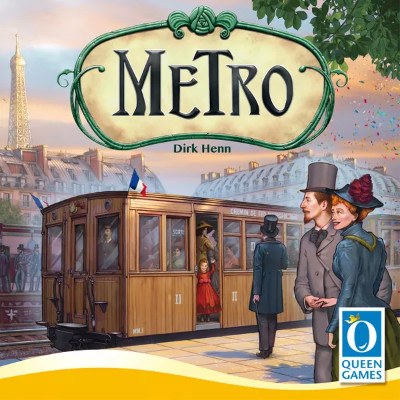Metro and Cable Car Board Game Review

By MARK WILSON

Year Published: 1997/2009
Players: 2-6
Playing Time: 30-45 Minutes
If I invoke “trains and stock-holding” it will send some hobbyist board gamers running for cover, while others will flock to it.
Metro, and its sequel Cable Car (I’ll be covering them both in this review) have trains and stock holding. But they don’t fall into the traditional mold of stockholding games that feature trains.
Paradoxical, I know. But we’ll come back to that.
Instead, these games teach and play fairly intuitively, include elements that abstract the proceedings more than usual, but still contain some ideas that will be familiar to fans of stock-holding, route-building games.
The Gameplay
In Metro, you’ll have a particular color of train, and you want to connect these trains, which sit neatly in their starting locations, to stations with the most lucrative rail lines.
To do this, you’ll be placing square tiles that have convoluted, winding pathways, like the scribblings of a particularly talented child who enjoys seeking patterns in the interplay of blowing leaves.
The longer the line, the better, since visiting a tile gives you points. You can also connect them to a limited number of central destinations for double their tile value.
That’s basically the whole game. The spatial jostling between players as they help themselves or undercut opponents is the entire appeal. With limited restrictions, you don’t have to extend your own line on your turn and can instead play antagonistically.
It’s fun, but not particularly special.
Therein ends my review of Metro’s base game. But to go further, and to explain why these games excite me, I have to talk about…
Metro’s Expansions
Metro received a series of well-regarded expansions. Cable Car, which we’ll talk about below, is more-or-less Metro as it exists with these expansions included.
I’m usually not one to extoll the virtues of expansions. Just as often as not, I think they add unnecessary bloat to games that are already what they need to be. This can be due to publishing demands and the hubris of designers that make something great and assume that “more” will automatically be “better.”
But sometimes that instinct is correct.
Metro’s expansions are modular little micro-additions, and I’m going to talk about one in particular. In it, instead of receiving a particular color of train, you’re given four stocks representing 10%, 20%, 30% or 40% of one of the colors (companies) on the board. So you might have a single rooting interest, like you do in the base game. Or you could have up to four. Moreover, the 40% stock you own will be the one you care about the most.
As an action, you can trade out of a stock to take another, but this must be done in the game’s early stages. Once companies hit a certain value threshold, you’re locked into the stocks you have.
This means, for example, that you and I may be working together on the Blue company. One of us will likely benefit slightly more than the other, sure, but to tank Blue’s chances is to ensure our mutual loss.
There’s still ample opportunity to sink the value of companies you have no stake in, and ideally you’re helping yourself while also hurting others. It makes for an interesting spatial puzzle, one with occasional shared incentives with other players even while you compete with them.
One other expansion module allows you to open a new train line for a company of your choosing. This is a pretty clear signal to opponents of what company you want to succeed, so while you have a new line to increase the company’s value, you’re also putting a target on your back.
There are a couple other modules I haven’t played with enough to review, but everything I discussed above is a categorical improvement to the base game’s formula, without bloating the game to an onerous length or complexity.
Cable Car – Gameplay
Cable Car is more-or-less Metro with its expansions. Some new artwork, maybe a minor rules tweak or two I’m unaware of as I write this. But what I just described above is a succinct description of Cable Car as well.
Wibbly Wobbly, Turny-Wurny Tile Laying
Tsuro, which ironically came out after Metro, is probably the best-known game of this type, with mazelike patterns on its tiles that create winding, looping paths across its board.
It’s quite engaging, aesthetically speaking. Tsuro’s main appeal for many – arguably it’s only appeal for some – is this aesthetically fascinating maze-building that occurs during gameplay.
The problem is that this can ultimately be a bit shallow unless it’s accompanied by other considerations. I enjoyed Tsuro for a bit, and enjoy tons of light games. But it was one that wore thin very quickly, since there’s really not much gameplay to it.
Metro has this same aesthetic appeal, but also layers it into a spatial puzzle where there are lots of things that can inform your strategy, but very little in the way of certainty.
Metro’s Core Tensions
With everything out in the open minus expansions, there are fewer tensions in the game. The addition of stocks (which, if it wasn’t obvious, are hidden) means that you can never be sure who you’re helping or hurting, and to what extent.
But as the game unfolds, you’ll piece together each player’s primary interests, so that you really do have a good mental map of the game state. There’s some light deduction here, but sometimes it’s comically light since not all players will try to hide which rail companies they’re most interested in helping or hurting.
Still, it’s another level of intrigue, particularly early on when you can sometimes grab some quick points before anyone is wise enough to thwart you, or set your companies up for midgame success but without being too obvious about which ones you’re trying to help.
The other tension is in the tile-laying itself, which is the core of the game. Help yourself? Hurt others? Ideally both, but figuring out when and how to do this becomes trickier than it may seem.
I’m not going to sit here and pretend this is wildly deep gameplay. It’s not. You play tiles and watch cable cars do loop-de-loops. I’d call this a family game if I’m categorizing it, but with enough going on that it can reward repeat plays since there are at least a few levels that it’s working on.
The Analysis Monster
In its base version, both games dictate that each tile can only face one particular direction. This is to cut down on the analysis that can occur when you have, say, 25 different places to place a tile, AND four different configurations of that tile.
A variant rule for the game allows you to break the core rule and rotate the tile in any direction. This is how I prefer to play.
Personally, I’ve not seen this freedom result in too much downtime when I’ve played. But I also see how it’s possible, particularly if you are playing with someone prone to a lot of indecision when they’re faced with a large decision space.
I like that the game includes the default orientation, though, for groups who may be concerned about this. You still have loads of choice when it comes to tile placement, but not quite so much that it can be overwhelming.
Metro & Cable Car – Conclusions
Games that teach and play in under an hour, have fun little gimmicks (the looping tiles), are directly interactive without being mean (and at times actively promoting cooperation), and have enough depth to reward numerous plays are great. In fact, there aren’t lots of games I could say each of those things about.
Metro/Cable Car isn’t as densely strategic as many others in related “train” genres, but it’s not trying to compete with those and is better off for it. Any that play as quickly as Metro aren’t as fun for me.
It’s also not going to produce wild swings of fortune or high drama. The tactical puzzle is interactive and intellectually engaging, but the experience is enjoyed in the aggregate, not for any one momentous point. As such, I could see some landing on a more tepid conclusion, that it’s serviceable and solid but unspectacular.
For me, it’s at least a step above that. It teeters on the edge of one I want to own, having never pulled that trigger, but I’m also always excited to play it.
The quirky overlap of its theme, mechanics and playtime – I think – sort of buried it among many of its peers in the years they were released. A more recent 2024 re-release is promising, and frankly a bit surprising. I hope it pulls this one out of the realm of “hidden gem,” which is likely where I’d classify it currently.
…
Like my content and want more? Check out my other reviews and game musings!
Read More From Bumbling Through Dungeons
Recent Posts
Categories
- All (350)
- Announcements (4)
- Board Games (203)
- DMing (28)
- Game Design (16)
- Playing TTRPGs (22)
- Reviews (189)
- RPGs (142)
- Session Reports (91)
- Why Games Matter (9)